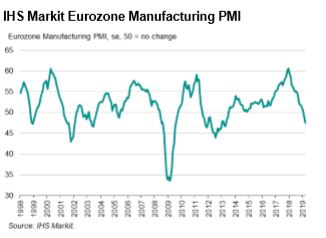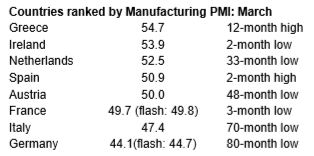KeyToMarketsUK
Well-known member
- Messages
- 436
- Likes
- 0
After a decent rally in early January, EURUSD shifted to a prolonged period of consolidation. So far this month, EURUSD remains neutral, but euro crosses beaten down more than 3.00%. The pound and loonie have performed strongly with 3.00% gains, followed by AUD and NZD with 2.00% against the euro. Whereas EURCHF is the superhero with a percent gain.
Economic data from euro area last week printed weaker than expected supported the ECB’s growth concerns. The latest Manufacturing and Service PMI surveys confirmed that the euro area economy edged to stagnation at the start of 2019,
according to IHS Markit.
ECB has now confirmed the downside risk in the EA, a dovish turn. Draghi confirmed that “The risks surrounding the euro area growth outlook have moved to the downside” and also highlighted that “The incoming information has continued to be weaker than expected.”
Data review: January EA PMI surveys retreated
ZEW President Professor Achim Wambach commented that “It is remarkable that the ZEW Economic Sentiment for Germany has not deteriorated further.”
Even an element of surprise could fail to move the ball beyond the given range 1.1570-1.1270. On top of the top-tier data releases market players also watching the US-China trade talks developments. Vice President Liu Hu will visit the U.S on Jan 30.
It is widely expected that the FOMC likely to keep policy on hold in Wednesday’s meeting and the also expect the first press conference of 2019 could wrap up with a lack of surprise.
Senior economist Bill Diviney at ABN AMRO said: “We think the 2019 set of voting members will have a more dovish tilt than that of 2018”.
In our view, ahead of the action pack week the trend in EURUSD looks titled settled within the 1.1570-1.1270 range. The price action is facing stiff resistance against the 100MAs, and the technical picture remains mixed.
As we forecasted on Friday, EURUSD rebounded to the target levels. We favor now to face stiff resistance against the 100MAs seems between 1.1445-1.1455. A break of these would give an impulse move higher to the next resistance 1.1500, paving the way for a more pronounced rally to the 200MAs seems between 1.1550-1.1570.
The flip side supports located at 1.1390, 1.1330 and 1.1290.

It is important to always keep in mind the risks involved in trading with leveraged instruments.
Economic data from euro area last week printed weaker than expected supported the ECB’s growth concerns. The latest Manufacturing and Service PMI surveys confirmed that the euro area economy edged to stagnation at the start of 2019,
according to IHS Markit.
ECB has now confirmed the downside risk in the EA, a dovish turn. Draghi confirmed that “The risks surrounding the euro area growth outlook have moved to the downside” and also highlighted that “The incoming information has continued to be weaker than expected.”
Data review: January EA PMI surveys retreated
- December Germany PPI decreased by 0.4% vs. +0.1% in Nov 2018, according to Destatis.
- The ZEW Indicator of Economic Sentiment for Germany increased slightly in January. According to the official data, the economic expectations are recorded an increase of 2.5 points to -15.00 recorded an increase of 2.5 points in January 2019, and now stands at minus 15.0 points vs. -17.5 in November, well below the long-term average of 22.4.
ZEW President Professor Achim Wambach commented that “It is remarkable that the ZEW Economic Sentiment for Germany has not deteriorated further.”
- Germany January PMI reading fell below 50.0 to 49.9, 50-month low vs. 51.5 in December whereas Services PMI increased to 53.1, 2-month high vs. 51.8 in December, according to IHS Markit.
- Turning to EA, January Manufacturing PMI fell to 50.5, 50-month low vs. 51.4 in December and Services PMI fell to 50.8, 65-month low vs. 51.2 in December.
- Ifo Business Climate Index fell from 101.0 points in December to 99.1 points in January, dropping to its lowest level since February 2016, according to the CES.
Even an element of surprise could fail to move the ball beyond the given range 1.1570-1.1270. On top of the top-tier data releases market players also watching the US-China trade talks developments. Vice President Liu Hu will visit the U.S on Jan 30.
It is widely expected that the FOMC likely to keep policy on hold in Wednesday’s meeting and the also expect the first press conference of 2019 could wrap up with a lack of surprise.
Senior economist Bill Diviney at ABN AMRO said: “We think the 2019 set of voting members will have a more dovish tilt than that of 2018”.
TECHNICAL OVERVIEW
In our view, ahead of the action pack week the trend in EURUSD looks titled settled within the 1.1570-1.1270 range. The price action is facing stiff resistance against the 100MAs, and the technical picture remains mixed.
As we forecasted on Friday, EURUSD rebounded to the target levels. We favor now to face stiff resistance against the 100MAs seems between 1.1445-1.1455. A break of these would give an impulse move higher to the next resistance 1.1500, paving the way for a more pronounced rally to the 200MAs seems between 1.1550-1.1570.
The flip side supports located at 1.1390, 1.1330 and 1.1290.
It is important to always keep in mind the risks involved in trading with leveraged instruments.
What is your Technical View?
Do you have a different idea? Please leave us a comment and get an answer from our professional analysts
Do you have a different idea? Please leave us a comment and get an answer from our professional analysts


